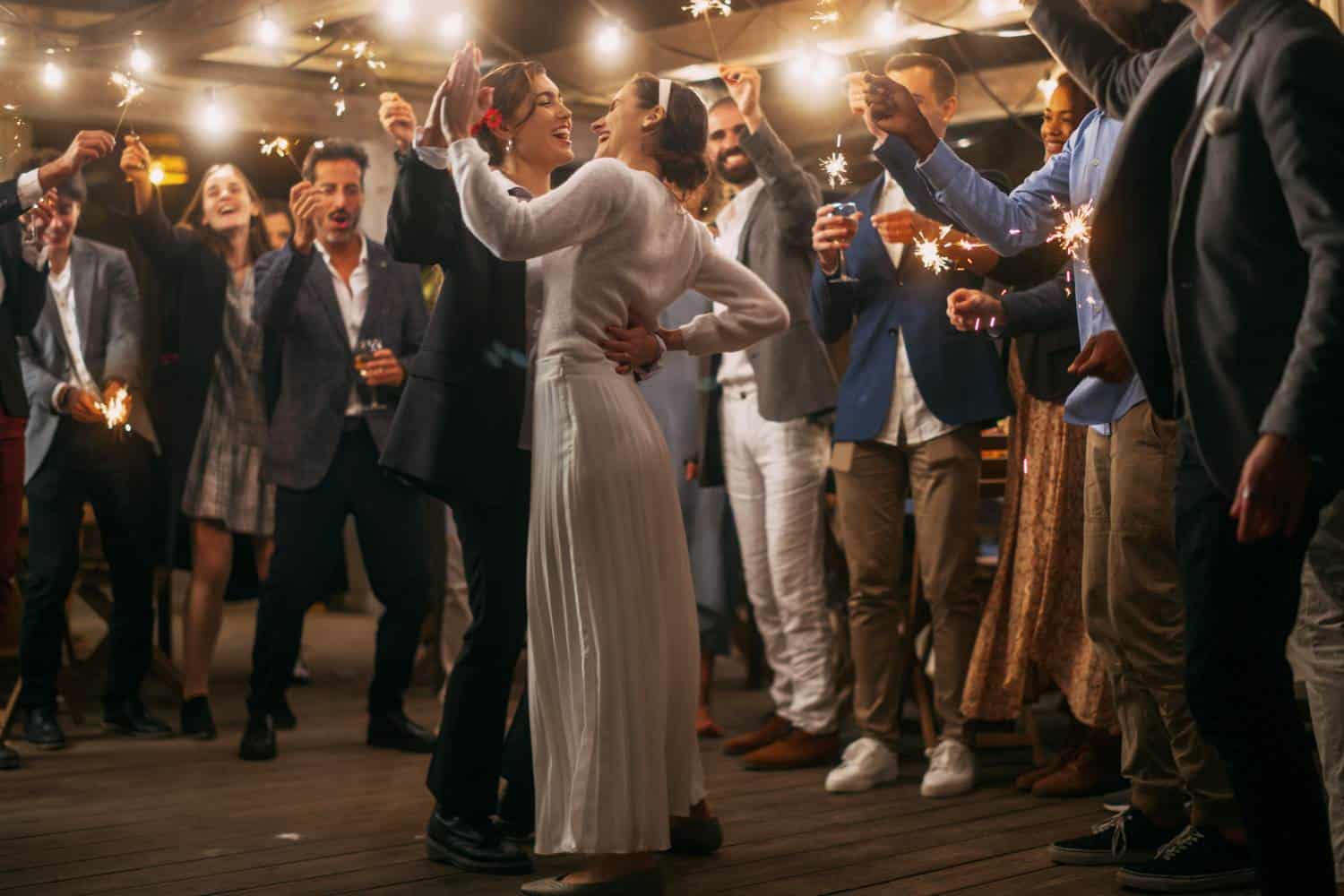Choosing the perfect wedding reception gown can be one of the most exciting parts of wedding planning.
Your reception gown is not just about style—it also needs to reflect your personality, suit the venue, and keep you comfortable throughout the event.
With countless options in fabrics, styles, and silhouettes, narrowing down the right choice can feel overwhelming.
However, a clear understanding of your preferences and venue details can make the process smoother and enjoyable.
Let’s get straight to the point
Selecting the perfect reception gown involves balancing style, comfort, and practicality.
Start by recognising your personal style—whether it’s classic, modern, or bohemian—and consider how it complements your wedding theme.
Match your gown to the venue, keeping in mind that different locations (beach, rustic, or grand) require different styles.
Prioritise comfort with proper fit, breathable fabrics, and ease of movement, as you’ll wear it for hours. Accessorise thoughtfully, staying within your budget, and choose a silhouette that flatters your body shape.
Schedule final fittings to ensure a perfect fit, and you’ll enjoy both looking and feeling amazing on your big day.
1. Recognising Your Style
Your reception gown should be an extension of your personal style.
Whether you prefer classic, modern, or bohemian, your gown should resonate with your taste and complement the overall theme of your wedding.
Think about what styles you naturally gravitate toward in your everyday life.
Style Inspirations
- Ball Gowns: These timeless dresses bring elegance and grandeur, ideal for traditional weddings. The voluminous skirt adds a royal touch, making you feel like a true princess on your big day.
- Sheath Dresses: Sleek and modern, these are perfect for brides who favour simplicity and minimalism. This style’s clean lines and close fit offer a contemporary look without excessive embellishments.
- Lace Dresses: A popular choice for bohemian or rustic-themed weddings. Lace adds a touch of romance and delicacy, blending perfectly with natural, outdoor settings.
Before making a decision, browse bridal magazines, websites, and social media for inspiration.
Once you understand your style preferences, it’s easier to narrow down your options.
2. Considering The Venue
The venue plays a significant role in selecting your reception gown. Your dress should not only suit the atmosphere but also be practical for the setting. Different venues require different gown considerations.
Matching The Gown To The Venue
- Grand Venues (Manor Houses or Castles): Opt for gowns with long trains, intricate beading, or lace, which add to the formality and elegance of the space. These features elevate your look to match the opulence of the surroundings.
- Beach Weddings: Lightweight, airy fabrics like chiffon or silk are perfect. The dress should flow naturally and allow for movement in the sand, ensuring you remain comfortable in a more relaxed setting.
- Rustic Settings: Lace or vintage-inspired dresses pair beautifully with barn or forest weddings, adding a touch of romance and whimsy. The organic texture of lace complements the natural, earthy feel of the venue.
The venue’s size also influences gown choice. A smaller, more intimate venue may be better suited to a simpler design, while larger spaces can accommodate more voluminous gowns.
3. The Importance Of Comfort
Comfort should be at the forefront of your decision-making process. A reception gown might look stunning, but if it’s uncomfortable, it could distract you from enjoying the day.
Since you’ll be wearing the dress for several hours, it’s important to choose something that allows ease of movement.
Considerations For Comfort
- Fit and Size: Ensure your gown fits properly. Ill-fitting dresses can restrict movement and cause discomfort. Multiple fittings help refine the fit so you can move freely and confidently.
- Fabric Choice: Lightweight and breathable fabrics are ideal, particularly for outdoor weddings. Avoid heavy materials that can cause overheating, especially in warmer weather or more active parts of the day.
- Mobility: Your dress should allow you to sit, dance, and move comfortably. Test the gown during fittings to see how it feels when moving. You’ll be wearing it for hours!
- Undergarments: Select supportive undergarments that match your dress’s style, enhancing the overall comfort and fit. Well-chosen undergarments can also improve posture and ensure your gown sits smoothly.
Choosing a gown that balances style and comfort ensures that you can fully participate in all the events of the day without feeling restricted or uncomfortable.
4. Accessorising Your Gown
Once you’ve chosen your reception gown, the next step is accessorising. Accessories can add a unique touch to your look, enhancing the dress while reflecting your personality.
However, it’s important not to overdo it—accessories should complement your gown, not compete with it.
Popular Accessories
- Veils: A classic choice, available in various lengths and styles. Choose one that complements the formality and design of your dress. Cathedral-length veils add drama, while shorter veils offer a modern twist.
- Jewellery: Choose pieces that match the style of your gown. Pearls or diamonds can add subtle elegance, and statement pieces can offer a bold focal point if your gown is simpler.
- Shoes: Prioritise comfort when selecting shoes. Choose a style that complements your dress but is comfortable enough for dancing. Consider lower heels or cushioned insoles for extra ease.
- Hair Accessories: Tiaras, combs, or floral pieces can complete your hairstyle and add a touch of glamour. These accessories can align with the theme of your wedding, whether it’s romantic, vintage, or modern.
- Clutches: A practical accessory, clutches are perfect for carrying essentials without compromising style. Choose a design that coordinates with your gown but is small enough to be unobtrusive.
When accessorising, keep the balance between simplicity and elegance in mind. Too many accessories can distract from the beauty of the gown, while the right pieces will enhance your overall look.
5. Budgeting For Your Gown
Setting a budget for your reception gown is essential. Wedding attire can be expensive, so it’s important to know how much you’re willing to spend before shopping.
Steps To Determine Your Budget
- Set a Realistic Figure: Consider your total wedding budget and decide how much you can allocate for the gown. This figure should include the cost of the dress, as well as any potential alterations and accessories. Keeping room for extras ensures no unexpected expenses.
- Research: Before visiting bridal stores, research the price range of gowns you’re interested in. This can prevent you from falling in love with a dress that’s out of your budget. Knowledge of price points ensures you’re looking at options within your range.
- Discuss with Consultants: Be transparent with bridal consultants about your budget. They can guide you toward options that fit your financial constraints, helping you avoid disappointment later.
Alterations can add to the overall cost of your gown. Factor these expenses into your budget to avoid any surprises later.
6. Silhouette And Body Shape
Understanding your body shape is essential when choosing a gown that flatters you. Different silhouettes work better for different body types, so it’s important to select one that highlights your best features.
Common Gown Silhouettes
- A-Line: Universally flattering, this silhouette suits most body types and creates a balanced, elegant look. It skims over the hips, giving a smooth and sophisticated shape.
- Ball Gown: Perfect for brides with a pear-shaped figure, as it accentuates the waist while providing volume to the skirt. The fullness of the skirt can help create an hourglass silhouette.
- Sheath: Best for taller or slimmer brides, this silhouette creates a sleek, streamlined appearance. Its close fit can elongate the figure and add a contemporary feel.
- Mermaid: Ideal for brides who want to emphasise their curves, the mermaid silhouette hugs the body before flaring out at the knees. This style enhances hourglass figures by drawing attention to the waist and hips.
Try on different silhouettes to see what makes you feel the most confident and comfortable. Your reception gown should not only look beautiful but also make you feel amazing.
7. Final Fitting And Alterations
Once you’ve chosen your gown, it’s important to schedule final fittings to ensure the dress fits perfectly on your wedding day.
Tips For The Final Fitting
- Timing: Schedule your final fitting 4-6 weeks before the wedding. This allows time for any last-minute adjustments without the stress of rushing.
- Bring Accessories: During the final fitting, bring your shoes and undergarments to see how the gown works with the full ensemble. This ensures that everything comes together seamlessly on the big day.
- Test Movement: During the fitting, test how the dress feels when you walk, sit, and dance. Ensure that it’s comfortable for all aspects of the reception. You want to be as comfortable dancing as you are during the ceremony.
Alterations are a normal part of the process, so don’t worry if adjustments need to be made. Bridal consultants and seamstresses are skilled at making gowns fit perfectly.
Conclusion
Choosing the perfect reception gown is about finding a balance between style, comfort, and practicality.
By considering your personal taste, venue, and comfort needs, you can select a dress that not only looks stunning but also allows you to enjoy your special day to the fullest.
Budget wisely, discover different silhouettes to find the one that flatters you best, and finalise the look with thoughtful accessories.
With careful planning and attention to detail, your reception gown will reflect your personality and make you feel truly beautiful as you celebrate with loved ones.
Frequently Asked Questions
How Far In Advance Should I Start Looking For My Reception Gown?
It’s advisable to start your search for the perfect reception gown at least 6 to 9 months before your wedding.
This timeframe allows for browsing, trying on different styles, placing orders, and accommodating any necessary alterations. Starting early helps reduce stress and ensures you have plenty of time to find a gown that you truly love.
Can I Choose A Reception Gown That’s A Different Colour From Traditional White?
Absolutely! While white is traditionally associated with weddings, modern brides embrace gowns in various colours.
Whether you’re drawn to soft pastels, vibrant hues, or sophisticated metallics, choosing a gown in a colour that reflects your personality and complements your wedding theme can make your reception outfit uniquely yours.
What’s The Best Way To Determine My Budget For A Reception Gown?
Determining your budget involves evaluating your overall wedding expenses and deciding how much you’re comfortable spending on your attire.
Allocate a percentage of your total wedding budget to your outfit, including alterations, accessories, and any other related costs.
Be transparent about your budget when shopping, and explore various options, from bridal boutiques to online retailers, to find a gown that fits both your vision and budget.
How Do I Know Which Gown Silhouette Will Suit My Body Type?
The key to finding the most flattering silhouette is understanding your body shape and what styles best enhance your features.
A-line gowns are versatile and flatter most body types, while mermaid or trumpet styles accentuate curves.
Ball gowns add drama and are ideal for those looking for a classic, fairy-tale look. Consider consulting with a bridal stylist who can recommend the best silhouettes for your body type and personal style.
Is It Necessary To Have A Final Fitting, And How Close To The Wedding Should It Be Scheduled?
Yes, a final fitting is crucial to ensure your gown fits perfectly on your special day. It’s typically recommended to schedule your final fitting about 2 to 4 weeks before your wedding.
This timing allows for any last-minute adjustments while ensuring the gown still fits perfectly, considering any slight body changes that may occur close to the wedding.



